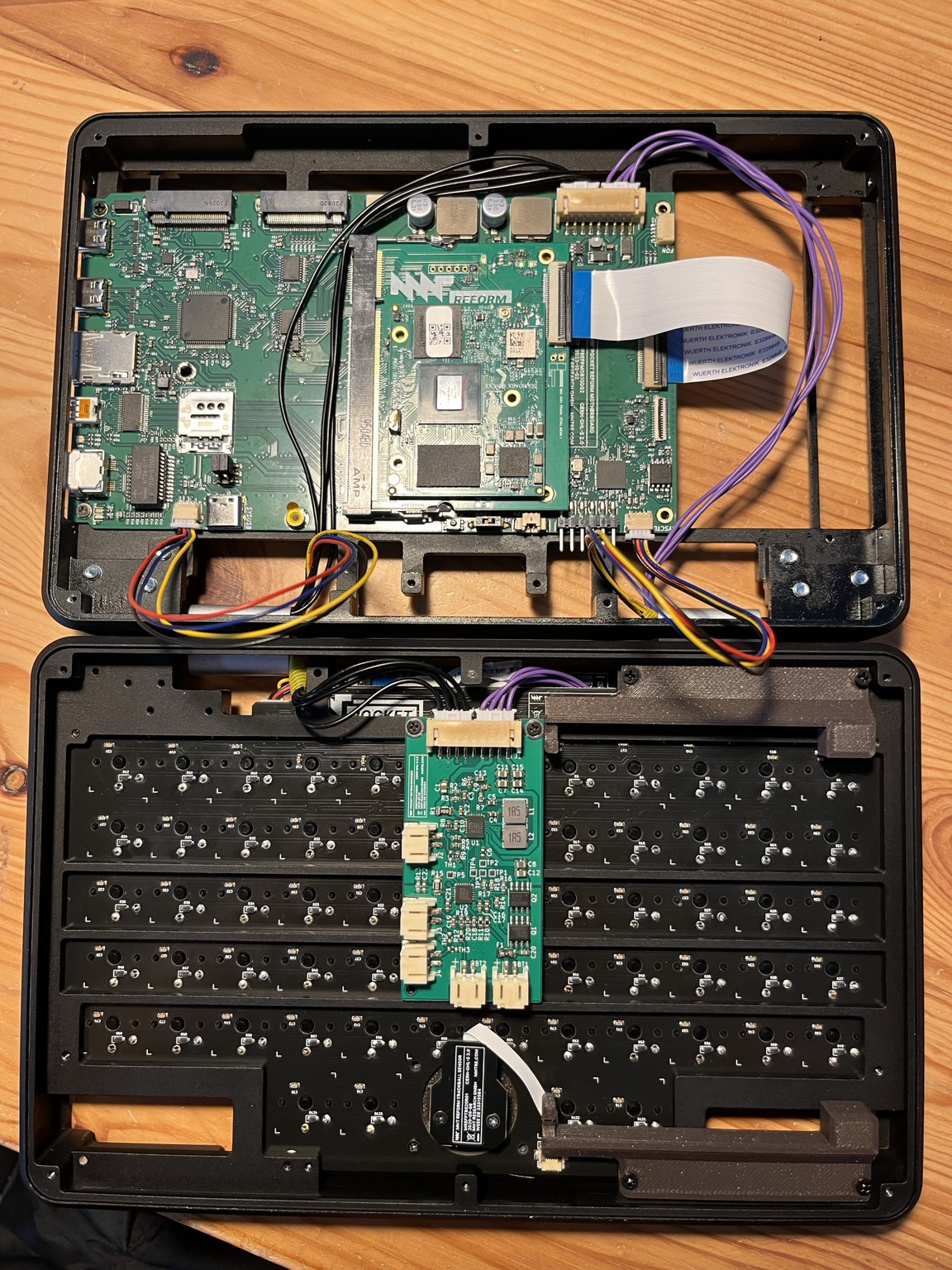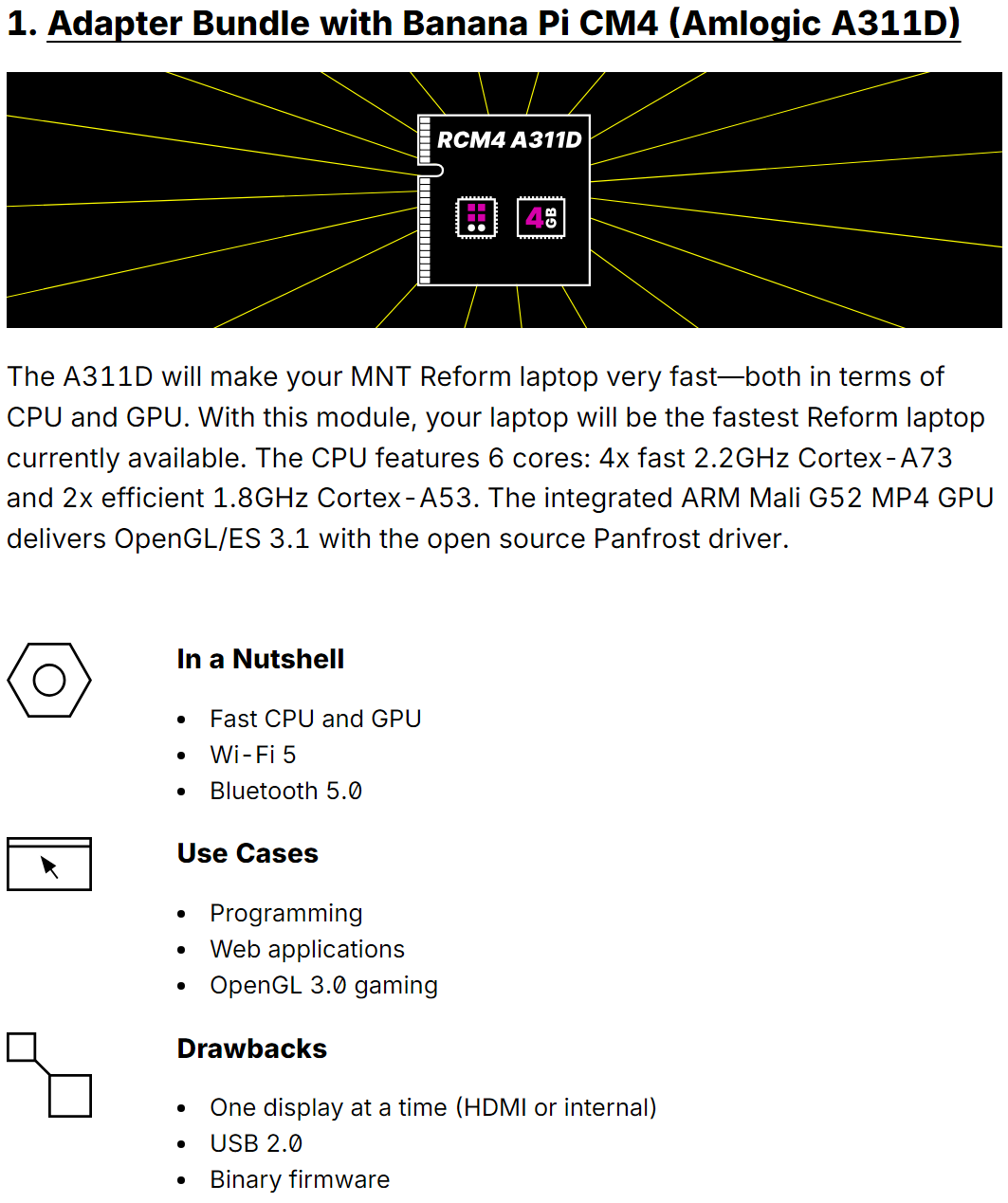MNT November 2023 Update
We hope autumn is treating you well. We'd like to give you a small update on what we have achieved since our last update three months ago.
Pocket Reform Shipping Update
As Pocket Reform has so many parts and components, we are still in the process of validating, improving and ordering many of them.
The so-called "Motherboard Release Candidate 1" (MRC1) has been assembled by Greta and we are happy to report that everything is working. All known bugs have been fixed and both the modem and the SSD fit well in their respective places.
The MRC1 has gained some new features: a headset port (equivalent to MNT Reform) on the left side of the device, which was previously unused. Additionally, we've added a small QWIIC connector. This allows you to connect your own sensors, e.g. I2C signals to RP2040. We also plan to place a Wi-Fi chip antenna on the new headphone board, but in case of insufficient performance, we will use an adhesive antenna instead. Lukas has modified the port placement by a few millimeters so that different types of connectors have enough space next to each other.
We have improved the weight of the aluminum CNC (case) parts as we deemed them too heavy. These parts are now lighter than before (which means that Pocket Reform itself will be lighter as well) and the samples we have received look great, so we have placed the order today.
Regarding fit & finish of the case plates, we have ordered final prototype samples and if these are satisfactory we will order them in bulk along with the final keyboard and trackball PCBs (which we are also content with). Pocket Reform sleeve production is currently being organized.
We 3D printed the battery holders as they are no longer integrated into the metal, which makes it possible to insert different or larger batteries later on.
The Quectel EM06 cellular module has been validated—it can even make and receive calls (we have tested this feature with Vodafone Germany/CallYa), but the audio is not working yet. We hope we'll get it to work for the final version, but we also don't want to delay fulfillment because of it. Lukas is doing their best and we will keep you posted on this. Side note: our main focus with cellular is internet connectivity, not voice.
There is one issue we have that concerns the TUSB8040 hub: during the chip crisis we had 500 of them in stock. In 2023, we used them on the Reform motherboard 2.5 and found that 10% of the chips on the boards didn't work—so we had to rework them. This cost us a lot of time (and energy), so we will update the hub chip to a new version (TUSB8041). The new version is more energy-efficient and with the newer version yield issues are less likely.
LS1028A Shipping Status
We've shipped out the first LS1028A modules to our customers and were excited to receive their positive feedback. We have managed to acquire the missing 36 chips (of the 50x batch) directly from NXP, which have already arrived and have been soldered by our board house, so we will be able to fulfill all open orders very soon. We'll have a small stock available after fulfillment of the remaining orders.
In the meantime, take a look at the incredible mod by Dirk Eibach, who has modified Reform to be powered by only one battery pack and installed two extra Ethernet ports in the freed up space for robotics applications.
System Image V4
In September, we released version 4 of the MNT Reform system image which includes considerable changes and improvements.
Thanks to josch who once again contributed many improvements to the MNT Reform system build process and tooling.
This new version introduces reform2-a311d (for RCM4+BPI processor module) as well as reform2-ls1028a (for LS1028A processor module) as a new platform.
In terms of accessibility, we now ship only two minimalist but customized desktop environments as default: sway and wayfire.
This decision seems to resonate with our Reform users: "Now we get one floating and one tiling window manager, both of which are pretty lightweight and comfortable to use." (inhji)
Inhji has also praised the addition of reform-tray as it "has made the system in general beginner friendly and I really appreciate that." The tray icon menu is designed to find help and essential system controls quickly.
We replaced rofi with wofi (wayland native) as a launcher, implemented reform-synaptic as a wrapper to run synaptic package management GUI on wayland and added dunst as notification daemon. LXPolkit, blueman-applet, nm-applet and pasystray are now autostart programs. We have added foot as the new default terminal as it is really fast, and the new default browser of MNT Reform is Mozilla Firefox.
System Image V4 also unifies rescue and "full" image into one, more minimalistic image.
To reduce the size of the image, we have removed some applications, which can of course be installed manually by users who wish to use them. These include Gnome, KDE, Chromium, LibreOffice, Gimp, Inkscape, KiCad, FreeCAD, DOSBox and some minor programs.
Illustrative MNT Reform Shop Page
Doing Open Hardware is not an easy task. Communicating what it is that we're actually doing, our products themselves, but also the philosophy and principles behind them, is at times equally difficult.
Most people have heard of Open Source, but the concept of Open Hardware is still very much underrepresented and therefore niche. This is probably why we sometimes receive feedback like, "This is super interesting, but I don't really understand what it is that you're doing and what it is about." We want to change that, and we already took action to describe and explain the notion of Open Hardware more on our website and why we are taking this path. We want to make the reception of what we do, our philosophy, even more accessible.
The MNT Reform shop page was one of the pages that seemed to be a bit overwhelming for our customers, so we really want to make it easier to understand. We restructured the text and highlighted the important information, so it can be grasped quickly. Visuals can help a lot in that regard, which is why Anri has created some icons that illustrate these details better. These graphics are designed to give you a better overview of the most popular CPU modules and the benefits and drawbacks of each.
The fediverse was very excited about this—what do you think? Do let us know if you find this helpful and if you'd like us to go into this direction even further. (see our contact information below)
Side note: we are also trying to make our products more (financially) accessible if we can, so we've reduced the costs of both the 1 TB SSD and the 2 TB SSD.
Community Contributions
We always appreciate contributions by members of our community and we would like to highlight some of the most helpful contributions in this update.
Valtteri Koskivuori has contributed code improvements to various firmware: a fix for the jumpy keyboard backlight as well as an implementation for keyboard fade-in and fade-out animations so that the backlight now fades in smoothly on startup. Additionally, Valtteri adjusted the trackpad's firmware to make it more responsive and less latent. He also added a ~30s timeout to the MNT Reform logo on the OLED screen to prevent burn-in.
When Lukas tested and merged Valtteri's contributions, they became aware of two minor issues with the keyboard firmware that are now fixed. There was a low battery alert (a flashing icon on the OLED screen) which hadn't worked for a long time. Now that it has been fixed, it works again. Another issue concerned the battery percentage of MNT Reform in shutdown state: Lukas has removed the brownout reset in the system controller firmware, so that Reform now remembers the battery percentage even when powered off.





